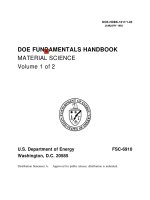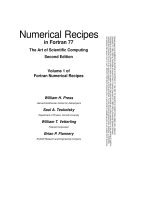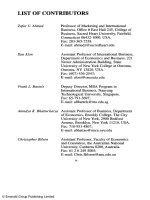- Trang chủ >>
- Khoa Học Tự Nhiên >>
- Vật lý
Pylkkänen, p (ed ) bohm biederman correspondence, vol 1 (routledge, 2002)
Bạn đang xem bản rút gọn của tài liệu. Xem và tải ngay bản đầy đủ của tài liệu tại đây (933.72 KB, 285 trang )
BOHM-BIEDERMAN
CORRESPONDENCE
BOH M-BI EDERMAN
CORRESPONDENCE
DAVID BOHM AN D
CHARLES BIEDERMAN
Volume One:
Creativity and Science
Edited by
Paavo Pylkkänen
London and New York
First published 1999
by Routledge
11 New Fetter Lane, London EC4P 4EE
This edition published in the Taylor & Francis e-Library, 2002.
Simultaneously published in the USA and Canada
by Routledge
29 West 35th Street, New York, NY 10001
The letters of David Bohm © 1999 Sarah Bohm
The letters of Charles Biederman © 1999 Charles Biederman
Selection and editorial matter © 1999 Paavo Pylkkänen
All rights reserved. No part of this book may be reprinted or reproduced
or utilized in any form or by any electronic, mechanical, or other means,
now known or hereafter invented, including photocopying and recording,
or in any information storage or retrieval system, without permission in
writing from the publishers.
British Library Cataloguing in Publication Data
A catalogue record for this book is available from the British Library
Library of Congress Cataloging in Publication Data
Bohm, David.
Bohm-Biederman correspondence/David Bohm and Charles Biederman;
edited by Paavo Pylkkänen.
p. cm.
Includes bibliographical references.
Contents: v. 1. Creativity and science—
1. Bohm, David—Correspondence. 2. Physicists—England—
Correspondence. 3. Biederman, Charles Joseph, 1906– —Correspondence.
4. Artists—United States—Correspondence. 5. Art and science. 6. Creation
(Literary, artistic, etc.) 7. Creative ability in science. I. Biederman, Charles
Joseph, 1906– . II. Pylkkänen, P. (Paavo) III. Title.
N72.S3B64 1999
001'.092'2–dc21
[B] 98–24759
CI P
ISBN 0-415-16225-4 (Print Edition)
ISBN 0-203-00803-0 Master e-book ISBN
ISBN 0-203-20158-2 (Glassbook Format)
CONTENTS
Acknowledgements
PAAVO PYLKKÄNEN
vii
Foreword
M.H.F.WILKINS
ix
Preface
CHARLES BIEDERMAN
xii
Editor’s Introduction
PAAVO PYLKKÄNEN
I
II
xiii
A New Vision of Totality
March 6, 1960
March 26, 1960
April 11, 1960
April 24, 1960
May 22, 1960
June 6, 1960
June 28, 1960
3
4
6
8
19
27
35
Creative Determination
August 1, 1960
October 3, 1960
November 17, 1960
December 28, 1960
45
54
61
73
vi
III
IV
V
Contents
Thought and Reality
February 2, 1961
March 2, 1961
February 24, 1961
May 29, 1961
87
98
103
115
Truth and Understanding
December 22, 1961
December 26, 1961
January 18, 1962
December 29, 1961
December 30, 1961
February 24, 1962
125
140
149
160
165
170
Beyond the Subject-Object Distinction
February 2, 1962
February 9, 1962
March 17, 1962
March 18, 1962
April 14, 1962
April 23, 1962
March 23, 1962
April 27, 1962
April 15, 1962
May 7, 1962
April 24, 1962
179
181
182
190
191
194
200
209
215
222
228
Chapter Summaries
PAAVO PYLKKÄNEN
232
Bibliography
Index
249
253
ACKNOWLEDGEMENTS
The publication of the Bohm-Biederman correspondence has been a
large project involving the generous help of many people. We are, of
course, extremely lucky that these letters have been preserved. This is
thanks to Charles Biederman, who preserved copies of the
correspondence. A very important role has also been played by David
Bohm’s wife Sarah, who has been energetic in her endeavour to further
Bohm’s work in many areas. She initiated this project by contacting
Biederman and has been responsible for many of the various
arrangements required to manage the vast project, which the publication
of a 4,000-page correspondence inevitably is. It has been a great joy to
work with Sarah.
Very special thanks also go to the English artist Anthony Hill,
who not only provided me with a lot of material on and by
Biederman, but also shared his fascinating views on Biederman’s
approach and its relation to Bohm’s thinking. Arleta Griffor has
done an invaluable job in organizing the material and in keying
Bohm’s hand-written letters onto diskette. Her deep and extensive
knowledge of Bohm’s philosophy has been very helpful throughout
the project. Thanks are also due to Sampo Karjalainen, who scanned
Biederman’s typed letters. Professor Basil Hiley, Lee Nichol and
David Peat have contributed to the project in various ways, not least
by discussing many of the ideas.
This project has been supported financially by the Academy of
Finland, the University of Skövde, Sweden, and by the Swedish Herbal
Institute Ltd, Gothenburg, Sweden. I am especially grateful to the head
of the Department of Humanities at Skövde, Seppo Luoma-Keturi, as
viii
Acknowledgements
well as to the Director of the Swedish Herbal Institute, Georg Wikman,
for their patronage. I should finally warmly thank Adrian Driscoll and
the editorial staff at Routledge who have recognized the special value
of this project and helped us in many ways.
Paavo Pylkkänen
FOREWORD
I met David Bohm in 1943 when I began, with other physicists, to
work on the horrendous atom bomb Manhattan Project at Berkeley
California. Bohm was very highly regarded as a physicist, but what
specially interested me was his exceptional breadth of interests
which ranged over the whole of human culture. This unusual
breadth linked with the fact that Quantum Theory, which was his
special area of research, involved revolutionary breadth of thinking.
Bohm was specially interested in the philosophical challenge of
the new Theory (which Einstein had failed to deal with). As an
experimental physicist, such philosophical problems did not
concern me directly. On the other hand, the post-war role of the
Atom Bomb much worried me and it was Bohm’s ideas about this
problem which brought me and him together. Some physicists on
the Project were narrowly fascinated by the idea of, after the war,
constructing new nuclear bombs of much greater power. Bohm’s
imaginative concern enabled him to see the dangers of such
developments. Like the great Quantum pioneer Niels Bohr, Bohm
saw the need for holistic approaches with open dialogue between
those with differing views. He saw that political analysis could not
be avoided. However, after the war McCarthyist extremism grew
and Bohm’s recognition of the political aspects of nuclear policy
led to his professional future in the United States being threatened.
Bohm moved to Princeton where Einstein welcomed him. But Bohm
was advised to leave the US because his passport might be taken
away. He decided to leave the country.
x
Foreword
After the war I worked on DNA which led me in 1952 to Brazil
where I met Bohm again and was very glad to find him developing his
ideas as before with creative courage and energy. A few years later he
settled in England. He married an artist (as I did) and, in order to
clarify ideas about a more unified culture, he began discussing with
artists the relationship of art and science. During the 1960s
environmental science began to make clear that science-based technology
was creating serious environmental problems. This, together with the
relentless background of the nuclear arms race, emphasised the need
for a new way of seeing the world. Studying interconnections in our
culture and developing an holistic philosophy was increasingly seen to
be necessary and, in response, new cultural movements appeared. The
British Society for Social Responsibility in Science (BSSRS) was formed
and stressed the need for more sense of community in science and
more integrated thinking about the problems of the world.
Following writing by novelist C.P.Snow on the gap between science
and art, a BSSRS group was formed, including Bohm and myself, to
examine the relation between art and science. We were stimulated by
symmetry in architecture (e.g. by Buckminster Fuller) and in newly
discovered viruses and giant molecules. BSSRS activities peaked in
1970; at a great conference which examined problems foreshadowing
today’s social and ethical concerns about molecular biology. There were
many distinguished speakers, including Bohm on holism and dialogue.
In the US Charles Biederman, well known Structurist artist and author
of considerable writings on the nature of art, became very interested in
Bohm’s ideas. Anthony Hill, a British artist with special interests in
mathematics, had told Biederman of the importance of Bohm’s new book
Causality and Chance in Modern Physics. As a result in 1960 an enthusiastic
correspondence began between Bohm and Biederman. On the other hand,
in Britain, although Bohm’s ideas attracted much attention in the 1970s
and after, the general movement of idealism and libertarianism of the
1960s and 1970s faded. Political conservatism grew and monetarism
increased its domination of the whole of culture. It was only after Bohm
died in 1992 that I became aware of the remarkable Art/Science
correspondence between Bohm and Biederman from 1960 to 1970. The
correspondence illustrated clearly Bohm’s ideas of dialogue and cast light
on how Art/Science ideas could point the way to increased unity in all
aspects of modern culture.
Today, with severe world-wide disunity in culture as a whole, it is
useful to recall the surprising degree of Art/Science unity which has
Foreword
xi
existed in the past. For example, the recent Tate Gallery exhibition
“Turner and the Scientists” reveals how Turner painted breath-taking
landscapes where beauty and spiritual force emerged with the aid of
careful study based on science such as meteorology and geology. This
was possible because the communities of science and art were then
closely linked (as was symbolised by the Royal Society and the Royal
Academy being next door to each other). Turner trained as a builder
and architect, mixed with poets and scientists and admired steamships,
railways and the Industrial Revolution. (See Turner and the Scientists by
James Hamilton 1998.) The Romantic movement had by no means
built a solid barrier between Science and Art. Similarly, seventeenthcentury scientists had viewed science as a way of “Reading the Mind of
God”. And, leaving aside Science/Religion opposition, in the nineteenth
century it was not unusual for astronomers to see the “Glory of God in
the Splendour of the Heavens”.
Today it is specially difficult to see science in a wide perspective.
One reason for this difficulty is that research workers find themselves,
like other professionals, under increasing pressure. But the need to see
science from wider angles is greater than ever. The Bohm-Biederman
correspondence gives unique illumination of Art/Science relations. It
illustrates very well Bohm’s ideas of creative dialogue and can help us
move towards greater unity in the modern world. Such unity is of vital
importance. The Bohm-Biederman correspondence demands most
careful study.
M.H.F.Wilkins
PREFACE
Charles Biederman
It was sheer chance that I encountered David Bohm’s writing in
1958, having ordered one of his books on speculation from a scientific
catalog. I knew nothing about him. What struck me about his work
and prompted my initial letter was his underlying effort to seek for
some larger sense of reality, which seemed a very humanized search.
This was further evidenced as our correspondence progressed, and
he made the effort to communicate with me beyond the private
language of physicists. I soon discovered that David was as concerned
with the disparities within his own field as I was with those within
mine. As a result, I remain indebted to him for the stimulus and the
urgency he brought to our discussions of the differing reality pursuits
of science and art and the humanities, although we arrived at our
respective conclusions only after our correspondence ended. I am
sure that David would have hoped that our mutual efforts would
stimulate others to confront the larger, neglected problem since
Leonardo da Vinci of our perception of reality as evidenced by
thousands of years of art and then by four centuries of modern
science. Now more than ever, it seems to me, the problem is
inescapable, and its resolution is crucial to the well-being of both
fields. Long ago Whitehead observed that Newton left nature
“without meaning or value”, and that the limitations of science were
“perhaps too narrow for science itself’. This, it seemed to me, was
also David’s view.
EDITOR’S INTRODUCTION
Paavo Pylkkänen
On March 6, 1960 the American artist Charles Biederman wrote to
the physicist David Bohm in London. Biederman had recently read
Bohm’s book Causality and Chance in Modern Physics (1957) which had
been recommended to him by the English artist Anthony Hill. For
Biederman the book had been a “tremendous experience to read”
and he wanted to let the author know this. What neither of them
realized at the time was that this one-page, spontaneous letter was the
first of over 4,000 pages of correspondence, to be written between
March 1960 and April 1969! In this first volume the early part of this
correspondence is published, namely the letters ranging from March
6, 1960 to April 24, 1962.
David Bohm (1917–92) was one of the foremost physicists of his
generation and the author of many influential books. He is known in
particular for developing an alternative interpretation for the quantum
theory, the theory that deals with atomic phenomena. The first consistent
interpretation of the quantum theory was proposed in the mid-1920s
by Niels Bohr. It made the radical proposal that a deterministic
description of the movement of individual quantum systems (e.g.
electrons) was no longer possible, and even more strikingly, that we
should give up thinking of, say, an electron as just a particle and rather
see it as something that can exhibit both wave-like and particle-like
properties, depending on the experimental situation. In all this a kind
of undivided wholeness of quantum phenomena was emphasized. Bohm
started off as a supporter of Bohr’s point of view and even wrote one of
the best textbooks of its time, The Quantum Theory (1951), along these
xiv
Editor’s Introduction
lines. Gradually, however, Bohm grew dissatisfied with what he saw as
the fragmentary features of the Bohr approach, and here he was
influenced by discussions with Einstein in Princeton. He began to
examine whether a fuller description of quantum processes was possible,
and in 1952 published a consistent alternative hypothesis about the
quantum domain. This hypothesis went strongly against the prevalent
view by suggesting that individual quantum systems like electrons are
accompanied and determined by a new type of field, that they have a
well-defined existence as particles, and move deterministically along
trajectories. Yet it made very explicit some of the most radical features
of quantum theory, such as a holistic property known as non-locality.
The response to Bohm’s work was divided. Given that Bohr’s
interpretation was taught as the only possibility—sometimes
dogmatically—some were satisfied that Bohm had shown that an
alternative exists. Others felt that Bohm’s hypothesis was trying to avoid
the philoso-phically radical implications of Bohr’s view, such as
indeterminism and a kind of ambiguity of quantum phenomena.
Bohm himself saw his 1952 “causal intepretation” as a starting point
or a source of insight rather than as a final theory. But as many of his
fellow physicists were against the theory and as he could not obtain
new empirical evidence in its favour, he began to focus on different
things, to some extent returning to Bohr’s way of looking at the quantum
theory. However, he started to reconsider the causal interpretation more
seriously in the 1970s, partly as a result of the work he did together
with his colleague Basil Hiley and their research students at Birkbeck
College, London University. Bohm’s last ideas on the interpretation
are published in the book The Undivided Universe which he co-authored
with Basil Hiley and which was almost completed before Bohm’s death
in 1992. Although Bohm’s 1952 work was initially resisted, it is today,
in various developed forms, increasingly seen as a source of insight
into the fundamental problems of physics.
Since the early 1960s—which is the period when the correspondence
with Biederman began—Bohm started to develop a general framework
for physics which he later called the implicate order, known to the general
public through Bohm’s Wholeness and the Implicate Order (1980). One of
the values of the correspondence is that it shows the development of
Bohm’s ideas leading towards the implicate order. Bohm also made
significant contributions in many other fields, including philosophy,
psychology and biology. In discussions with the Indian teacher
J.Krishnamurti they explored human consciousness and the possibilities
Editor’s Introduction
xv
of its transformation. And in this correspondence, of course, we see
him engaging in an intense dialogue about the meaning of art and
artistic creativity. A biography that covers the various aspects of his
work has recently been written by F.David Peat (1996), and a useful
introduction to the more technical parts of his work can be found in the
introduction to Bohm’s Festschrift by Hiley and Peat (1987).
Charles Biederman (b. 1906) was the founder, in the late 1930s, of
an art form first known as Constructionism and later, in the early 1950s,
as Structurism. This art form, which is a kind of relief art organized
geometrically, developed from painting but shares its three-dimensional
properties with sculpture. According to the art historian and critic Donald
Kuspit (1985), “the key to Biederman’s works is the use of planar
geometrical elements as irreducible sensory—color—units, and their
integration into structures that seem dynamically evolving.” Thus
Biederman often describes his work as dealing with the “structural
process level of reality”. Biederman also wrote and theorized extensively
on art, the most notable example being his monumental book Art as the
Evolution of Visual Knowledge (1948) (referred to in the correspondence
itself simply as the Evolution book). Although he never became part of
the mainstream, Biederman strongly influenced some important English
artists such as Victor Pasmore and Anthony Hill and also held some
significant exhibitions, including a retrospective at the Hayward Gallery
in London in 1969. Illuminating discussions of Biederman’s works and
ideas can be found in, for example, Kuspit (1977) and Craven (1980a,
1980b), as well as in various exhibition catalogues.
In the foreword to Biederman’s Hayward exhibition catalogue, Robyn
Denny (1969:4) first notes that between 1936 and 1966, “Biederman
carried through one of the most radical and single-minded attempts in
modern art to formulate a new definition for art and its relation to the
organic world” and then goes on to consider the reasons for Biederman’s
neglect. One suggestion is that many people know Biederman only
through his theories which they do not accept, very few having seen
his work. Another reason is that while “art in America focused on the
idea of ‘object’ as an entity separated from the natural world, Biederman
was systemizing the Structurist comprehension of nature as a source of
art”. Biederman’s audience has been very specialized and connected by
an ideology and “a belief in the evolutionary process in art derived
from certain basic premises”. According to Jan van der Marck (quoted
in Denny 1969:5), the approach of this group is programmatic: “They
are concerned with the technical and the conceptual issues in the making
xvi
Editor’s Introduction
of their works. They have a mathematical or natural science orientation.
Finally they have a social ethic that may strike the critic as utopic.”
This explains, of course, why Biederman was interested in books like
Bohm’s Causality and Chance.
Robyn Denny thinks that Biederman’s Art as the Evolution of Visual
Knowledge (1948) played an important role in Victor Pasmore’s conversion
to abstract art which, in turn “has always been regarded as one of the most
glamorous landmarks in British postwar art” (Denny 1969:5). For Pasmore
and some other English artists Biederman’s book was very relevant:
Many artists have claimed Courbet and Cézanne, Monet and Mondrian
as prime sources of their creative sensibility…But Biederman in so doing
offered…a coherent, uncompromising and committed proposition for a
radical alternative to painting and sculpture which received an affirmative
response from this small group of English artists.
(Denny 1969:5)
Jan van der Marck notes that following Cézanne, Biederman is motivated
by structural processes he observes in nature, especially outdoors:
He studies nature’s “building methods” as they present themselves in a
dynamic interaction of form, space and light, and abstracts these insights
into a non-mimetic art of pure, geometric form. By proposing the
“structural process level” of reality as the source of art, Biederman offers
an alternative to two types of art which he opposes equally:
representational art, with its references to mimetic, visible reality, and
non-geometric abstract art, as it favours emotion over reason.
(van der Marck 1969:12)
Here is how van der Marck describes a Structurist relief.
[It] consists of a flat rectangular plane with an ingeniously organized
array of smaller planes attached to both the background and to one
another. Within the limitations of their geometric shape and parallel or
perpendicular positions, these planes create a unique arrangement of
volume and space.
(van der Marck 1969:12)
Robyn Denny notes that those who have not seen Biederman’s reliefs
before are often surprised at the intensity of colour and its optical
complexity: “For Biederman, colour and light are as essential ingredients
Editor’s Introduction
xvii
of each work as the substance and form of the structure itself.” And if
Denny at times has found Biederman’s arguments hard to connect with,
his work appears free from any idiomatic constraints. Biederman’s reliefs
contain an extraordinary degree of rigour, discipline and control. A sense
of order, a command of means, and uncluttered clarity of purpose…
There is no doubt in my mind that Charles Biederman has made a
unique contribution to modern art.
(Denny 1969:6)
To honour Biederman’s 90th birthday in 1996, the Tate Gallery
exhibited one of his works which it has in its possession.
The above throws some light on the factors that are likely to have
triggered the intense correspondence between Bohm and Biederman.
Perhaps the most important was the interest that the two men shared in
the natural world. The fact that they were approaching nature from
different angles, those of art and science, meant that they complemented
and in this sense needed each other in order to obtain a fuller
understanding of nature. Another factor was their dissatisfaction with
the dominant trends in their fields. This is evidenced by the fact that in
his very first letter to Bohm, Biederman draws a parallel between the
situation in art and in quantum physics. His idea was that in both art
and in physics traditional views of nature had become inadequate in
the late nineteenth and early twentieth centuries, and that in both fields
the mainstream had failed to respond adequately to the new situation.
For Biederman a favourite example of such a failed response was
Surrealism and for Bohm it was the “Copenhagen” interpretation of
the quantum theory. A further common factor was that both Bohm
and Biederman were proposing new and what they felt to be more
adequate views of nature in their respective fields. Finally, their
opposition to the mainstream and persistence in developing and holding
alternative views did not help them to gain respect amongst their
colleagues—the label of the maverick was appropriate to both men.
When the correspondence began, both men were already mature
thinkers and practitioners in their fields and consequently the knowledge
they draw upon in their letters is extensive. This is not, however, to say
that the letters are inaccessible to the general reader who may not possess
a detailed knowledge of Bohm’s and Biederman’s work. On the contrary,
the fact that we have here a physicist writing to an artist and vice versa
means that difficult ideas are often explained in a clear and simple
xviii
Editor’s Introduction
fashion. It is this that makes the Bohm-Biederman letters much more
accessible and relevant to the general reader than a correspondence
between theoreticians usually is. It will, of course, be helpful to have
some familiarity with their work prior to the correspondence. Thus,
for example, the reader may find it useful to have Bohm’s Causality and
Chance in Modern Physics to hand when reading the letters—this was, after
all, the text that prompted Biederman to write to Bohm in the first
place. Biederman’s writings are harder to obtain, but the articles
mentioned in the bibliography at the end of the book provide a fuller
introduction to his work which the general reader is likely to find helpful.
CREATIVE DETERMINATION
Bohm and Biederman discuss a wide range of topics in the letters
that follow. The fact that the form of the discussion is that of
correspondence means that there is a great deal of spontaneity in the
way the different topics come up. This makes it more difficult to
summarize the discussion and to find the main topics and themes.
Fortunately, Bohm himself makes a summary of this kind, notably in
his December 22, 1961 letter (L16, DB8), and to a lesser extent in his
April 15, 1962 letter (L30, DB16). The reader will find these summaries
useful, although they are, of course, written to Biederman rather than
to someone with no previous knowledge of the correspondence.
Certainly one central topic in the correspondence is the relationship
between human beings and nature, in particular as this has to do with
artistic creativity and scientific endeavour. I also think one is justified in
making the following simplified contrast between the overall styles of the
two thinkers: as a scientist Bohm is more concerned with understanding
nature as it exists independently of human beings, whereas Biederman
as an artist is more concerned about the meeting of human beings and
nature, and properties that come into being as a result of that meeting.
Through his scientific and philosophical thinking, Bohm aims first to
formulate a vision of nature as a creative process and then to understand
human beings and human creativity in terms of that vision. Biederman’s
Structurist art, in turn, focuses on the special role of human beings: the
Structurist artist discovers and reveals those creations inherent in nature’s
process which only human nature can actualize.
This basic initial difference of approach shows itself in many of the
individual debates. For Biederman, nature considered without human beings
Editor’s Introduction
xix
is determinate and there is no room for properties such as chance,
indeterminism, disorder, randomness. lawlessness, etc. as objective. These
only arise in the meeting of human beings and nature and they are projected
on to nature by us. This explains why Biederman approves of Bohm’s
argument in Causality and Chance in Modern Physics in which he opens up the
possibility that the quantum level, currently the basic level of nature, can
be seen as deterministic, contrary to what the prevailing “Copenhagen”
interpretation of the quantum theory had claimed. It appears that Biederman
prefers the view of nature—when understood independently of human
beings—as relatively simple, determinate and straightforward and sees
complexity as arising only when human beings and nature meet.
Those who view Bohm as a simplistic determinist—and there may still
be quite a few—would expect him to have approved of Biederman’s
attitude. Bohm’s overall response to Biederman—as well as much of Bohm’s
published work since the mid-1950s at least—reveals, however, that his
concept of “human-independent” nature is far more complex and
permeated by features such as indeterminism and contingency than that
of, say, Biederman. This state of affairs is indeed captured by Biederman’s
remark to Bohm: “What you want to attribute to nature, I attribute
exclusively to man” (L11, CB6, December 28, 1960). In a number of
letters we find Bohm trying to convince Biederman how various properties
such as chance, randomness, contingency, possibility, etc. can be seen as
objective properties of human-independent nature. This ought to surprise
those who have seen Bohm as a simplistic determinist, perhaps based on
their reading of Bohm’s 1952 papers on “hidden variables”. For here we
have Bohm, who is internationally known as a defender of a deterministic
interpretation of the quantum theory, and thus for many a defender of
strict determinism in nature, arguing strongly for the objective existence
of properties such as contingency, chance, indeterminism, etc. Of course,
Bohm does this already in Causality and Chance, but here the point is made
more vividly, given that Bohm is defending the role of indeterminism
rather than questioning it, as he most famously did in his 1952 papers.
Regardless of the differences in their approaches, we find the two
thinkers developing many common themes and ideas as well. An
important idea is that of creative determination, which Bohm and Biederman
see as different from and going radically beyond either mechanistic
determinism or pure chance and chaos. A related and very interesting
discussion has to do with the concept of time. Bohm summarizes their
discussion as follows in his December 22, 1961 letter to Biederman
(L16, DB8):
xx
Editor’s Introduction
Each moment traces its past and projects its future in a unique way. At
each moment there is an infinity of possibilities, which (we both agree)
have, in some sense, a real existence. You argue that man can choose
from these possibilities, and nature by itself cannot.
The past is not by itself fully determinate, but is ambiguous as to
what it is (or was). The future helps to determine what the past really
was. Thus, the past does not fully determine the future. (If only because
in some measure, the future partly determines the past.)
It is through arguments such as the above that Bohm and Biederman
try to make room for a new type of “creative determination”. One idea
is that if the past does not fully determine the future, this leaves room
for the present moment to make a creative contribution. This discussion
also relates to the perennial philosophical debate between determinism,
freedom and responsibility. If the laws of physics completely determine
the behaviour of our bodies, how can we be held responsible for our
physical actions? And even if we allow chance and indeterminism in
the laws of physics, what difference would it make? For then the
behaviour of our bodies could be governed by, say, a combination of
deterministic and random laws, and this does not seem to capture what
is meant by responsible action either. In trying to develop a concept
that goes beyond either pure chance or strict determinism, Bohm and
Biederman are thus tackling not only the question of artistic creativity
or creativity in nature, but also the problem of understanding how
responsible action is possible if we are physical beings.
In my view their discussion of creative determination and time brings
up fresh viewpoints that are often neglected by philosophers. For example,
when philosophers discuss issues such as determinism, they often bring
relatively simplistic notions of physics into the discussion. Bohm’s
suggestion that the past is ambiguous is related to the uncertainty principle
of the quantum theory. The idea that the present moment can make a
creative (rather than random or strictly determined) contribution has
thus to be understood within the wider, quantum-theoretical idea of the
“ambiguity of the mode of being of parts” which Bohm explains in his
second letter to Biederman. This is not to claim that Bohm and Biederman
have come up with definite solutions of important problems in their letters.
But they certainly discuss some very difficult issues in novel ways, which
may well benefit contemporary researchers struggling with these topics.
To help the reader deal with the vast amount of information in the
correspondence, at the end of the book I have provided a brief summary
xxi
Editor’s Introduction
of each letter. These summaries are inevitably selective and thus by no
means do full justice to the various letters. They should be taken as a
rough guide for orienting around the material rather than as a precise
summary and evaluation of the contents of the letters.
Personally I think that the Bohm-Biederman letters are an extraordinary
treasure. We live in an age where science and technology increasingly
need to serve the interests of economic growth and immediate practical
applications. The adverse effects of science and technology are well known,
but it seems to be impossible to control and foresee developments such as
those in information technology. For example, how will the current
developments in this technology affect human consciousness? Will
consciousness have to mechanize itself in order for the new information
technology to function efficiently? Similarly, it is hard to see the role of
art in the “postmodern” era. Much of “serious” contemporary art is
inevitably linked with commercial-ization and mass-media culture. The
Bohm-Biederman letters provide a space in which one can critically reflect
these contemporary developments and glimpse alternative directions.
REFERENCES
Craven, D. (1980a) “The Art of Charles Biederman”, unpublished PhD thesis,
University of North Carolina, Chapel Hill.
Craven, D. (1980b) “Charles Biederman’s Art of Complicity”, Arts Magazine,
March, pp. 130–5.
Denny, R. “Introduction”, in Charles Biederman: A Retrospective Exhibition with
Especial Emphasis on the Structurist Works of 1936–69 (exhibition catalogue for
the Hayward Gallery, London, and the Museum and Art Gallery, Leicester),
Arts Council of Great Britain, London.
Hiley, B.J. and Peat, F.D. (1987) Quantum Implications: Essays in Honour of David
Bohm, Routledge, London.
Kuspit, D.B. (1977) “Charles Biederman’s Abstract Analogues for Nature”,
Art in America, May/June, pp. 80–3.
Peat, F.D. (1996) Infinite Potential: The Life and Times of David Bohm, Addison
Wesley Publishing Co. Inc., Reading, Mass., and Harlow, England.
Van der Marck (1969) “Biederman and the Structurist Direction in Art”, in
Charles Biederman: A Retrospective Exhibition with Especial Emphasis on the Structurist
Works of 1936–69 (exhibition catalogue for the Hayward Gallery, London,
and the Museum and Art Gallery, Leicester), Arts Council of Great Britain,
London.
(Note: For a full listing of works by and on Bohm and Biederman, please
refer to the Bibliography at the end of the book.)
I









